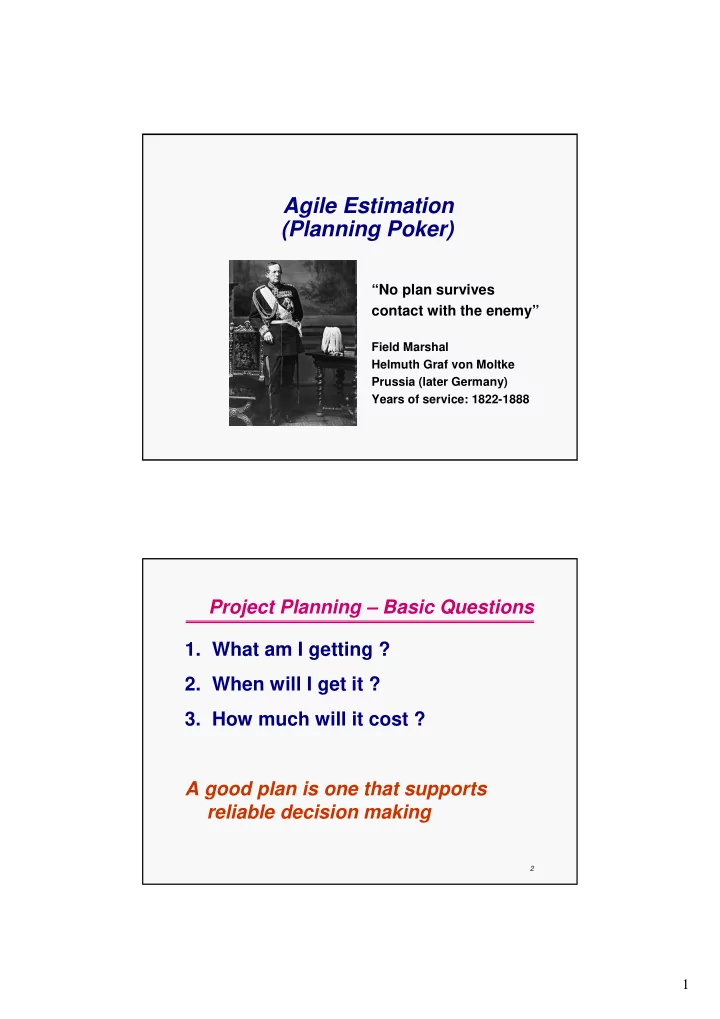

Agile Estimation (Planning Poker) “No plan survives contact with the enemy” Field Marshal Helmuth Graf von Moltke Prussia (later Germany) Years of service: 1822-1888 Project Planning – Basic Questions 1. What am I getting ? 2. When will I get it ? 3. How much will it cost ? A good plan is one that supports reliable decision making 2 1
Planning “The plan is nothing; the planning is everything” � Dwight Eisenhower � Allied supreme commander during World War II � 34 th President of United States (1953-61) 3 Project Planning Time (Schedule) Cost (Budget) The Project Triangle Functionality (Scope) Business Value 4 2
Planning “A good plan violently executed now is better than a perfect plan executed next week” – General George S. Patton 5 Estimation Accuracy 100 Accuracy Effort 6 3
Project Scheduling � Identify tasks � Estimate tasks � Allocate resources to tasks � Schedule tasks � Define product delivery schedule 7 How Long Will it Take? � To read the latest Harry Potter book? � To drive to Niagara Falls? � To do your calculus homework? 8 4
Size & Duration Size Duration Calculate Hours Lines of Code (LOC) LOC/Hour Days Distance Speed Weeks Words Words/Min Months 9 Answering the Right Question - Size = 80 Java source lines - Rate = 10 Lines/Hour - Duration = ?? Ideal time = 8 hours There are 40 hours in a work week, so the task will be completed on Monday! but – On Mon/Tues there were three hours of meetings, two hours of emails and three hours of field support Elapsed time = two days 10 5
Velocity Ideal Time (8 hrs) Elapsed Time = (16 hrs) Velocity (0.5) 11 Agile Estimating � Estimate by analogy � Compare features or “stories” being estimated with one another. � “This story is a little bigger than that story” � aka Triangulation � Evidence that we are better estimating relative size than absolute size � Unit-less estimates also known as “story points” 12 6
Assign “Dog Points” to these breeds: 5 1 10 3 5 3 9 3 13 Planning Poker � Wideband Delphi Technique (circa 1946) � Allows groups to quickly reach consensus � Everyone’s voice is heard � Exposes important project questions � Emphasize relative estimation 14 7
Playing Poker � One member of the team reads the feature story to be estimated � “Customer logs in to the reservation system” � “Customer enters search criteria for a hotel reservation” � Each member selects a card without revealing their estimate (1,2,3,5,8,13,20,40) � Cards are simultaneously displayed � High and low estimates are explained, short discussion ensues � Repeat as needed until estimates converge 15 16 8
Remodel Your Room � Install ceiling fan in existing electrical fixture � Hang three shelves � Paint four walls � Paint trim � Replace broken glass in window � Paint ceiling � Hang four posters � Set-up desktop computer and monitor � Shampoo carpet � Hang plasma monitor � Install door lock � Assemble new desk 17 Velocity � Relative estimates for each story � Customer identifies priority � Each completed story has a business value � Developers identify dependencies � Shampoo the carpet after painting � Run the first iteration (two weeks), determine how many stories were completed . � The total of story points is the team’s velocity 18 9
Back to Planning…. Stories (features) # of Iterations = Total Story Points / Velocity 19 Scrum Planning…. Sprints Product Backlog # of Sprints = Total Story Points / Velocity 20 10
Important caveats � Successful projects deliver working software frequently that gives the customer business value. � The project schedule is reviewed after each iteration and velocity is updated as needed. � The agile approach requires a big commitment on the customer’s part to provide details for each story. � Other planning techniques exist. Learn about several approaches and pick the one that best fits your project’s needs. 21 11
Recommend
More recommend